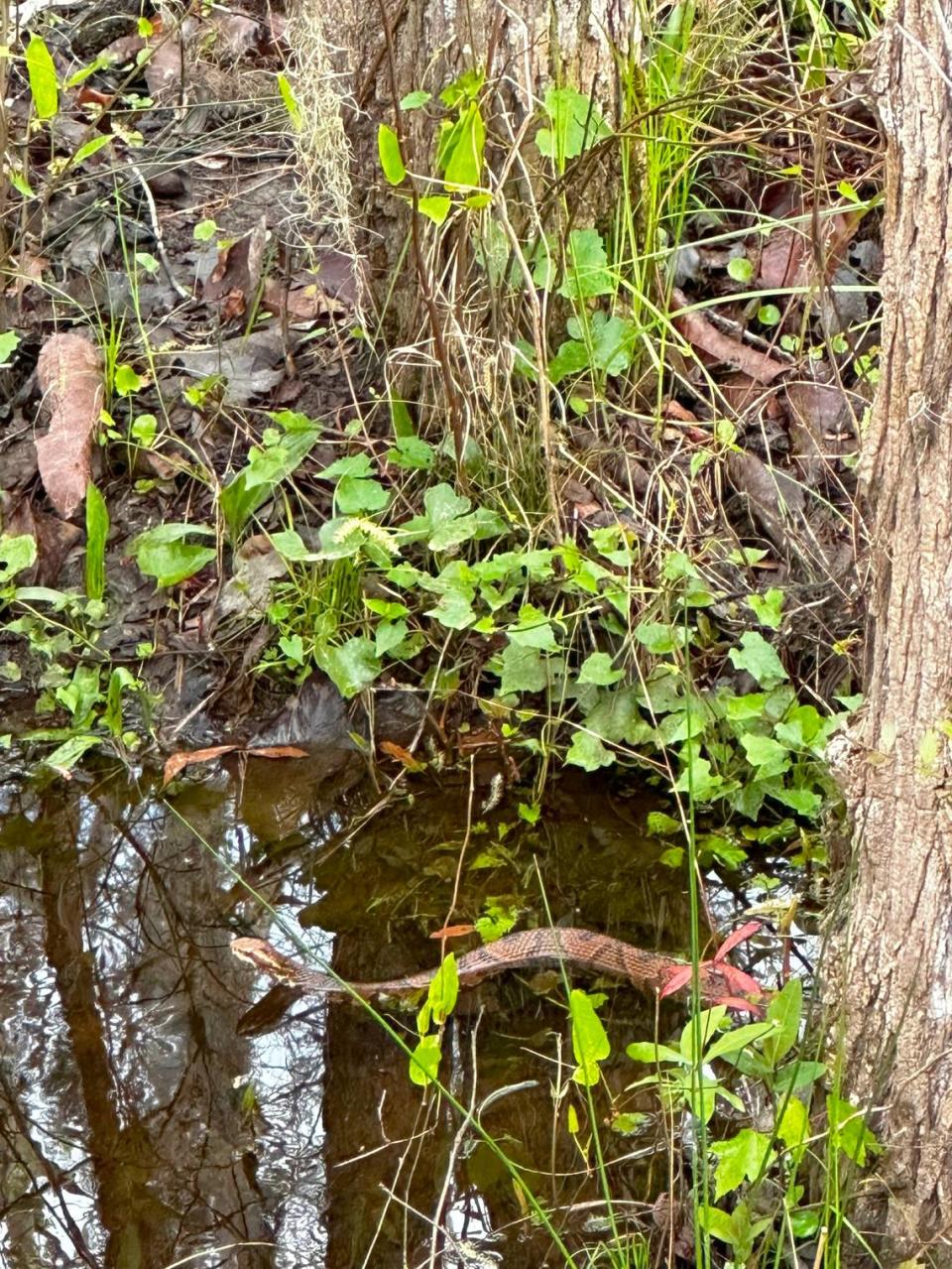During morning stroll, Bluffton man ran into this venomous creature. ‘Be careful on your walks’
John and Rose Helm were walking their Labradoodle early Monday when they had a surprise sighting of 3-to-4-foot long venomous cottonmouth snake in their Hampton Lake community of Bluffton. While not uncommon in South Carolina, the native snake species with a big reputation is not a regular sight at larger housing developments where native swamps and forests are not as abundant. But this snake was looking right at home sitting on the water in a wet, woodsy area, just several feet from a sidewalk.
Helm, a California native who is a plant biologist, is fascinated by snakes and interested in learning more about them in his adopted home of South Carolina. Initially, he was not sure if the species he and his wife encountered was a copperhead or a cottonmouth. Out of curiosity, he took a photo and submitted it to two Facebook sites dedicated to snake identification including South Carolina Snakes: Identification and Education, which has more than 40,000 members.
Both sites reached the same conclusion: The snake the Bluffton couple witnessed was a northern cottonmouth, which is common to coastal areas and sometimes called water moccasins.
“Best enjoyed from a distance,” one of the sites replied after confirming it was a cottonmouth.
“My wife was pretty scared of it,” Helm said, “but I’m fascinated by them honestly.”

After seeing Helm’s photo, Andrew Grosse, state herpetologist for the South Carolina Department of Natural Resources, confirmed the snake was an adult northern cottonmouth, the only cottonmouth species in South Carolina (the Florida cottonmouth is not found in South Carolina)
Because of its lively skin pattern, Grosse thinks the cottonmouth that Helm and his wife saw was probably on the younger side. Older cottonmouths typically have darker skin without as much pattern.
The state is home to around 40 snake species including six that are venomous.
The cottonmouth, says Grosse, is a shorter, “robust” snake that can reach lengths of 2 to 4 feet.
Typically, you’re less likely to see one in a well-manicured housing development, says Grosse, because they prefer wild and woolly swamps, wetlands and forests over man-made habitat like ponds. Hampton Lake, which features hundreds of houses, is centered around a 165-acre man-made lake and also features seven miles of navigable waterways and 15 miles of shoreline. Wetlands and wooded areas are sprinkled throughout the community.
“Certainly in those forest wetlands,” Grosse said, “that’s where they call home.”
“They’ll eat everything from frogs to amphibians and even other snakes,” Grosse added. “Anything they can find in those ecosystems.”
If threatened, cottonmouths will hold their ground and menacingly open their mouths wide, exposing dagger-like fangs and their telltale cotton-colored mouth. But despite their fearsome reputation, Grosse said, cottonmouths get a bad rap. They don’t usually strike unless they are stepped on or picked up, he says, and other snakes are quicker to attack.
“People hear stories about how aggressive they are and they chase people around,” Grosse says. “It’s just not true. It takes a lot to get one to bite you.”
Cottonmouths also are frequently confused with non-venomous water snakes, Grosse adds. Cottonmouths have a dark eye stripe and they tend to swim on top of the water whereas water snakes are quicker to dive, Grosse said. Another big difference is water snakes tend to slither away from people whereas a cottonmouth might sit curled up in a defensive position with their mouth open.
One interesting note about cottonmouths is they sport bright yellow tail tips when they are tiny. They wiggle those tails around like a worm to attract prey such as lizards and small frogs before pouncing.
Helm has seen his share of timber rattlesnakes in his home state of California, but the sighting of a live South Carolina cottonmouth was a first. At the time, he and his wife were strolling along Hampton Lake Crossing, not far from the Amenity Center, and just up the road from their home. A father and his young daughter were watching it from the sidewalk when the Helms came on the scene.
Later, Helm posted this message on the social media side Nextdoor: “Be careful on your walks.”

